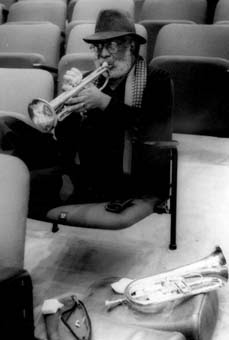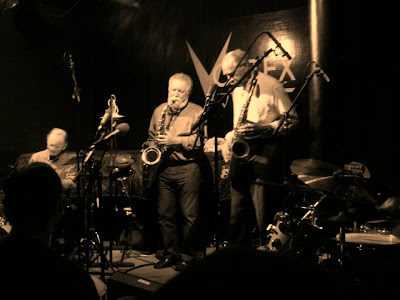Words: Gian Paolo Galasi
 |
| Cover of 'Bill DIxon 1982', Ferrary Gallery, 1982 |
Time to get
a little deeper into Dixon Verona
The
relationship and reciprocal influence between Dixon Dixon
GL: Do you see any similarities in the way you
prepare and perform your music and the way you prepare and present your
artwork?
BD: Not now. Perhaps at one time. Don’t forget,
in the performance of music now, for me, the whole preparation is being able to
play the instrument. If I was going to play tomorrow, whether solo or with a
trio or quartet, I will practice the instrument based upon trying to maintain
flexibility, so if in the process of playing I need to execute something, I
will have traveled that route before and I can execute it. I don't try to
practice things that I can play. I don’t try to practice sequences. When it’s
time for me to play, I don’t know what I’m going to do until the minute I play
the first note, and the first note I play will dictate what I’m going to do.
What I try to do is be a blank slate upon which things can be imprinted.
With painting, with the other artwork, I can
work on something and it can be finished; but I can look at it again the next
day and if I don’t like the way it looks, I’ll take a part and move it around.
I move things around when I write music.
 |
| In 1981, photo by Hans Kump |
With this
in mind, try to listen, again or for the first time, recordings such near in
time as Bill Dixon 1982 and Bill Dixon in Italy
It is
difficult to say if this shift was conscious or unconscious, while the effect
is that of a musician that, in solitude, try to occupy the background space and
shift on the foreground, and viceversa, by himself, whereas while accompanied
by another musician or a more or less extended group, the levels shifting is
realized through superimpositions from the different players.
 |
| Bill Dixon on 'Jazz Hot', December 1973 |
Something
Clifford Allen well noticed on his AAJ comprehensive article on the musician,
as quoted on part
one of this series, but now’s the time to go a little further. If Dixon, as
some of his contemporaries and next generation followers, worked extensively on
both the aural and visual paradigm – as an example, Anthony Braxton and Wadada
Leo Smith do this, as clearly evident even from the interview
the AACM-rooted trumpeter gave me last year, and as will be from my following
writings on the multi-instrumentalist, composer and ‘tri-axium’ writer, it is
also true that in this he was only making the same effort of many contemporary
artists, which is to go beyond the divisions in the world of the art we suffer
in Western culture since the separation of music from other arts and
disciplines, as from the half of 1700 on.
While
inviting to read Davide
Sparti’s writings on the subject, I’d love to contextualize more Dixon
As much an
outsider as sopranist Steve Lacy, possibly the nearest figure, since both were
working ‘on the border’ – of sound, on the most imperfect of the reeds instrument
family Lacy; of music, painting and teaching/composing Dixon - the trumpeters’
was one of the most vivid efforts to create an organic expression and artistic
vision. Going on in listening to his Soul Note recordings, this will become
irremediably clear.
 |
| Bill Dixon in Italy, Soul Note 1980 |
Both the
volumes od Bill Dixon
in Italy Dixon
Alan Silva
was taking part of Dixon environment since their Cecil Taylor Unit and Jazz
Composers Guild days, and if you listen to his ESP and BYG records, Silva’s –
also a painter, as Dixon - conductions, inspired by the history of the
African-American music from Louis Armstrong to Sun Ra and Albert Ayler, with
whom he directly collaborated, passing through his teaching, go into a similar
direction – the use of permutations so to create structures out of notes, his
love for Xenakis’ steps ahead in written music and his clashes with Pierre
Boulez’ IRCAM after creating his own IACP school.
Cornetist,
trumpeter and composer Stephen Haynes, is still today the direct witness and
creative legacy-sharer of Dixon
 |
| Back cover of Bill Dixon in Italy vol. 1 L-R: Stephen Horenstein, Stephen Haynes, Bill Dixon, Freddie Waits, Alan Silva, Arthur Brooks |
Arthur
Brooks, former student at Antioch
College
Freddie
Waits, father of drummer Nasheet Waits, is well known for having played with Max
Roach and his M’Boom Collective, pianist Andrew Hill, and a theory of post-bop,
modernistic Blue Note-based acolytes as Donald Byrd, Freddie Hubbard and Lee
Morgan. Stephen Horenstein, composer and multi-reed player, born in Boston but
at the time of those recordings migrating in Israel to study at the Music and
Dance department of Tel-Aviv University, and Dixon’s student at Bennington, was
active in many festivals both in Italy and New York, and recorded with German
drummer Gunther ‘Baby’ Soemmer between many others.
If the
music on this couple of record can be described as ‘pastoral’, in a way that
reflects another similarity between personalities as different as Bill Dixon
and Miles Davis, the following November
1981 (Soul Note, 1981), featuring a quartet composed by Dixon, Silva,
double bassist Mario Pavone and drummer Laurence Cook, push the music into a
more nervous, nocturne flow. One of Dixon’s grooviest outputs, and possibly the
nearest to what we can expect from a NY-rooted musician, is in some way
extended by his follower Thoughts (Soul
Note, 1985), with the double basses of Peter Kowald, William Parker and again
Mario Pavone, while the reed section is completed by Marco Eneidi on alto and John
Buckigham on tuba.
 |
| Bill Dixon, Thoughts, Soul Note, 1985 |
It features
a photo shot by Dixon himself of a trumpet near a window, with its reflections
on the standing wall, while on the back cover one of Dixon painting is exposed
on a semi-opened bathroom door, with the column of what can maybe be taken as a
fireplace at the other side of the image, in a sort of triptych emanating
directly from the division of the space. The music on this record is kind of a
sum of Dixon’s small ensembles previous experiences, with the sinuous pulsing
of Thoughts, the meditating layers of
piano and horns of Windows, the
contemporary dialogue of silence and sound in For Nelson and Winnie (a Suite in Four Parts), with Eneidi as the
proper inheritor of Robin Kenyatta and Byrd Lancaster and a wider use of spacey
extensions of sound as always in Dixon’s music.
Son of Sysiphus (Soul Note, 1988) is possibly the most
‘classical’ Dixon
But none of
Dixon
 |
| Drummer Tony Oxley |
Vade Mecum sees also the double basses of William Parker
and Barry Guy, reaffirming a practice of music in which, as in Anamorphosis, the trumpet, surrounded by
the two bass pulses and the particular Oxley’s drumkit, his playing acquires an
extended use of both lighter and lower tones, while the two following volumes
of Papyrus (Soul Note, 1998) see
Dixon’s piano, as on Silver Point: Jeanne
Phillips, as both melodic and rhythmic instrument, even if the texture of
the compositions is always far from both dramatic, Eurocentric constructions,
and African American percussive references; while since Papyrus # 2, the trumpet gains a more pre-eminent role through
space as never before on a record. And if Oxley percussions are more
environmental than ever, with a consistency that reminds of the contemporary
evolution of electronic music, what both the musicians give life here is
something not that far from Pauline Oliveros’ Deep Listening project for music and arts.
Gillo
Dorfles, one of the most important and interesting art critics in Italy
As part of
Cage/postmodern heredity, as a link between discovery, spontaneity and memory,
Oxley self built set of percussions and Dixon half-valves, and sometimes
electrified and manipulated extensions of sound through space, are one of the
most important and conscious attempts coming from improvised music to put
together an idea of expression related to the notion of individuality and
self-discovery. Their album released in 2002 through label Victo featuring Cecil Taylor
on piano, is one of the most delicate, intimate recordings featuring the
pianist, in some way also destabilizing and uncanny, as reported in Kurt
Gottshalk review of the record on AAJ website linked here above.
Related discography:
Bill Dixon
in Italy
Bill Dixon
in Italy
November
1981 (Black Saint, 1981)
Bill Dixon
1982 (Ferrari Gallery, 1982)
Thoughts
(Black Saint, 1985)
Son of
Sisyphus (Black Saint, 1988)
Vade Mecum
(Black Saint, 1993)
Vade Mecum
II (Black Saint, 1993)
Odyssey
(self issued, 6 cd Box, 1996)
Papyrus -
Vol. 1 (Black Saint, 1998)
Papyrus -
Vol. 2 (Black Saint, 1998)
Cecil
Taylor/Bill Dixon

















